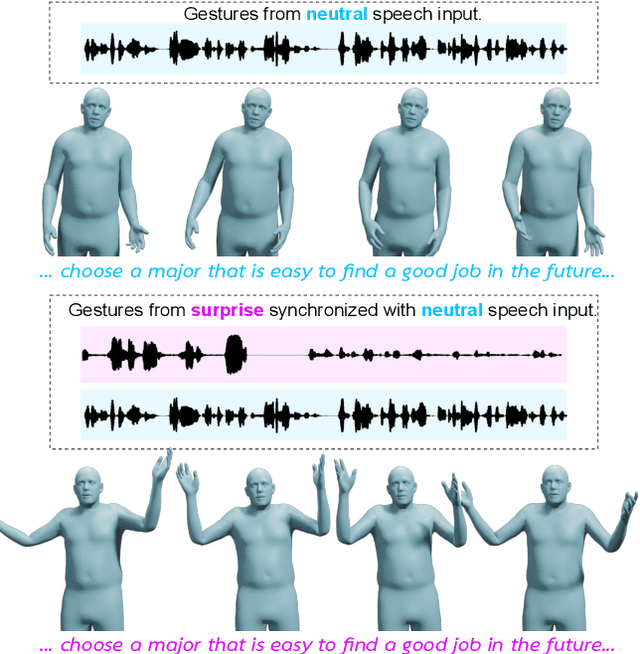Giorgio Becherini
MAMMA: Markerless & Automatic Multi-Person Motion Action Capture
Jun 16, 2025Abstract:We present MAMMA, a markerless motion-capture pipeline that accurately recovers SMPL-X parameters from multi-view video of two-person interaction sequences. Traditional motion-capture systems rely on physical markers. Although they offer high accuracy, their requirements of specialized hardware, manual marker placement, and extensive post-processing make them costly and time-consuming. Recent learning-based methods attempt to overcome these limitations, but most are designed for single-person capture, rely on sparse keypoints, or struggle with occlusions and physical interactions. In this work, we introduce a method that predicts dense 2D surface landmarks conditioned on segmentation masks, enabling person-specific correspondence estimation even under heavy occlusion. We employ a novel architecture that exploits learnable queries for each landmark. We demonstrate that our approach can handle complex person--person interaction and offers greater accuracy than existing methods. To train our network, we construct a large, synthetic multi-view dataset combining human motions from diverse sources, including extreme poses, hand motions, and close interactions. Our dataset yields high-variability synthetic sequences with rich body contact and occlusion, and includes SMPL-X ground-truth annotations with dense 2D landmarks. The result is a system capable of capturing human motion without the need for markers. Our approach offers competitive reconstruction quality compared to commercial marker-based motion-capture solutions, without the extensive manual cleanup. Finally, we address the absence of common benchmarks for dense-landmark prediction and markerless motion capture by introducing two evaluation settings built from real multi-view sequences. We will release our dataset, benchmark, method, training code, and pre-trained model weights for research purposes.
ContourCraft: Learning to Resolve Intersections in Neural Multi-Garment Simulations
May 15, 2024Abstract:Learning-based approaches to cloth simulation have started to show their potential in recent years. However, handling collisions and intersections in neural simulations remains a largely unsolved problem. In this work, we present \moniker{}, a learning-based solution for handling intersections in neural cloth simulations. Unlike conventional approaches that critically rely on intersection-free inputs, \moniker{} robustly recovers from intersections introduced through missed collisions, self-penetrating bodies, or errors in manually designed multi-layer outfits. The technical core of \moniker{} is a novel intersection contour loss that penalizes interpenetrations and encourages rapid resolution thereof. We integrate our intersection loss with a collision-avoiding repulsion objective into a neural cloth simulation method based on graph neural networks (GNNs). We demonstrate our method's ability across a challenging set of diverse multi-layer outfits under dynamic human motions. Our extensive analysis indicates that \moniker{} significantly improves collision handling for learned simulation and produces visually compelling results.
EMAGE: Towards Unified Holistic Co-Speech Gesture Generation via Masked Audio Gesture Modeling
Jan 02, 2024



Abstract:We propose EMAGE, a framework to generate full-body human gestures from audio and masked gestures, encompassing facial, local body, hands, and global movements. To achieve this, we first introduce BEATX (BEAT-SMPLX-FLAME), a new mesh-level holistic co-speech dataset. BEATX combines MoShed SMPLX body with FLAME head parameters and further refines the modeling of head, neck, and finger movements, offering a community-standardized, high-quality 3D motion captured dataset. EMAGE leverages masked body gesture priors during training to boost inference performance. It involves a Masked Audio Gesture Transformer, facilitating joint training on audio-to-gesture generation and masked gesture reconstruction to effectively encode audio and body gesture hints. Encoded body hints from masked gestures are then separately employed to generate facial and body movements. Moreover, EMAGE adaptively merges speech features from the audio's rhythm and content and utilizes four compositional VQ-VAEs to enhance the results' fidelity and diversity. Experiments demonstrate that EMAGE generates holistic gestures with state-of-the-art performance and is flexible in accepting predefined spatial-temporal gesture inputs, generating complete, audio-synchronized results. Our code and dataset are available at https://pantomatrix.github.io/EMAGE/
Emotional Speech-driven 3D Body Animation via Disentangled Latent Diffusion
Dec 07, 2023



Abstract:Existing methods for synthesizing 3D human gestures from speech have shown promising results, but they do not explicitly model the impact of emotions on the generated gestures. Instead, these methods directly output animations from speech without control over the expressed emotion. To address this limitation, we present AMUSE, an emotional speech-driven body animation model based on latent diffusion. Our observation is that content (i.e., gestures related to speech rhythm and word utterances), emotion, and personal style are separable. To account for this, AMUSE maps the driving audio to three disentangled latent vectors: one for content, one for emotion, and one for personal style. A latent diffusion model, trained to generate gesture motion sequences, is then conditioned on these latent vectors. Once trained, AMUSE synthesizes 3D human gestures directly from speech with control over the expressed emotions and style by combining the content from the driving speech with the emotion and style of another speech sequence. Randomly sampling the noise of the diffusion model further generates variations of the gesture with the same emotional expressivity. Qualitative, quantitative, and perceptual evaluations demonstrate that AMUSE outputs realistic gesture sequences. Compared to the state of the art, the generated gestures are better synchronized with the speech content and better represent the emotion expressed by the input speech. Our project website is amuse.is.tue.mpg.de.
 Add to Chrome
Add to Chrome Add to Firefox
Add to Firefox Add to Edge
Add to Edge